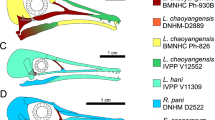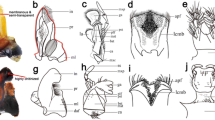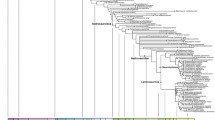Abstract
In several groups of insects, body structures related to feeding and oviposition are known to have a hardened cuticle by incorporation of transition metals. However, a functional link between metal enrichment and ecological pressures (i.e., adaptation) has been only rarely shown, opening the possibility that in some lineages, the evolutionary history may account for most of the observed variation (i.e., phylogenetic constraint). Here, we addressed this question in the hyper-diverse Hymenoptera (bees, wasps, ants, and sawflies), in which Zn and/or Mn have been found enriching the mandibles of a number of species. Across 87 species spanning most of the extant superfamilies, we found Zn enrichment to be widespread (57 species). Although lacking in the most primitive “Symphyta”, our ancestral state reconstruction was not conclusive in determining whether Zn enrichment was a derived state for the complete order, but it was clearly the ancestral state for the Apocrita, where it was lost in few lineages, notably in Aculeata (where it was then reacquired at least three times). Mn, on the other hand, occurred very rarely in mandibles (10 species). Our comparative analysis revealed a strong phylogenetic effect explaining most Zn % and Mn % variation in mandibles. Additionally, species with herbivorous larvae were less prone to have Zn (but not Mn) than those with carnivorous larvae, although a causal effect of diet on this trait was unlikely. Furthermore, species emerging from concealed vs. unconcealed development sites have similar likelihood to have metal-enriched mandibles. Evolutionary history seems to constrain metal enrichment in hymenopteran mandibles, yet the few observed losses and regains of this trait during evolution claim for deeper investigations on the role of alternative, here untested, ecological pressures.





Similar content being viewed by others
Data availability
All data generated or analyzed during this study are included in this published article (and its supplementary information files EDSdata.xlsx and Table S1).
References
Aguiar, A. P., Deans, A. R., Engel, M. S., Forshage, M., Huber, J. T., Jennings J. T., Johnson, N. F., Lelej, A. S., Longino J. T., Lohrmann, V., Mikó, I., Ohl, M., Rasmussen, C., Taeger, A., & Yu, D. S. K. (2013). Order Hymenoptera. In: Z. Q. Zhang, (Ed.) Animal biodiversity: an outline of higher-level classification and survey of taxonomic richness (addenda 2013). Zootaxa, 3703 (1), 51–62.
Ansari, T. M., Ikram, N., Najam-ul-Haq, M., Fayyaz, I., Fayyaz, Q., Ghafoor, I., & Khalid, N. (2004). Essential trace metal (zinc, manganese, copper and iron) levels in plants of medicinal importance. Journal of Biological Sciences, 4, 95–99.
Austin, A. D., & Dowton, M. (Eds.). (2000). The Hymenoptera: evolution, biodiversity & biological control. Melbourne: CSIRO Publishing.
Bagatto, G., & Shorthouse, J. D. (1994). Seasonal acquisition of mineral nutrients by a chalcid gall on lowbush blueberry. Entomologia Experimentalis et Applicata, 73, 61–66.
Bagatto, G., Zmijowskyj, T. J., & Shorthouse, J. D. (1991). Galls induced by Diplolepis spinosa influence distribution of mineral nutrients in the shrub rose. HortScience, 26, 1283–1284.
Baumann, K., Vicenzi, E. P., Lam, T., Douglas, J., Arbuckle, K., Cribb, B., & Brady, S. G. (2018). Harden up: metal acquisition in the weaponized ovipositors of aculeate hymenoptera. Zoomorphology, 137, 389–406.
Blomberg, S. P., & Garland, T. (2002). Tempo and mode in evolution: phylogenetic inertia, adaptation and comparative methods. Journal of Evolutionary Biology, 15, 899–910.
Bohart, R., & Menke, A. (1976). Sphecid wasps of the world: a generic revision. Berkeley: University of California Press.
Brewer, J. W., Bishop, J. N., & Skuhravý, V. (1987). Levels of foliar chemicals in insect-induced galls (Dipt., Cecidomyiidae). Journal of Applied Entomology, 104, 504–510.
Broomell, C. C., Mattoni, M. A., Zok, F. W., & Waite, J. H. (2006). Critical role of zinc in hardening of Nereis jaws. Journal of Experimental Biology, 209, 3219–3225.
Brothers, D. J., Tschuch, G., & Burger, F. (2000). Associations of mutillid wasps (Hymenoptera, Mutillidae) with eusocial insects. Insectes Sociaux, 47, 201–211.
Camargo, R. S., Hastenreiter, I. N., Brugger, M., Forti, L. C., & Lopes, J. F. S. (2015). Relationship between mandible morphology and leaf preference in leaf-cutting ants (Hymenoptera: Formicidae). Revista Colombiana de Entomologia, 41, 241–244.
Cribb, B. W., Stewart, A., Huang, H., Truss, R., Noller, B., Rasch, R., & Zalucki, M. P. (2008a). Insect mandibles-comparative mechanical properties and links with metal incorporation. Naturwissenschaften, 95, 17–23.
Cribb, B. W., Stewart, A., Huang, H., Truss, R., Noller, B., Rasch, R., & Zalucki, M. P. (2008b). Unique zinc mass in mandibles separates drywood termites from other groups of termites. Naturwissenschaften, 95, 433–441.
Cruaud, A., Cook, J. M., Yang, D., Genson, G., Jabbour-Zahab, R., Kjellberg, F., Pereira, R. A. S., Rnsted, N., Santos-Mattos, O., Savolainen, V., Ubaidillah, R., Van Noort, S., Yan-Qiong, P., & Raplus, J. Y. (2012). Fig-fig wasp mutualism: the fall of the strict cospeciation paradigm? In S. Patiny (Ed.), Evolution of plant-pollinator interactions (pp. 68–102). Cambridge: Cambridge University Press.
Degtyar, E., Harrington, M. J., Politi, Y., & Fratzl, P. (2014). The mechanical role of metal ions in biogenic protein-based materials. Angewandte Chemie, 53, 12026–12044.
Donovan, J. J., & Tingle, T. N. (1996). An improved mean atomic number background correction for quantitative microanalysis. Microscopy and Microanalysis, 2, 1–7.
Duncumb, P. (1994). Correction procedures in electron probe microanalysis of bulk samples. Microchimica Acta, 114, 3–20.
Edwards, A. J., Fawke, J. D., McClements, J. G., Smith, S. A., & Wyeth, P. (1993). Correlation of zinc distribution and enhanced hardness in the mandibular cuticle of the leaf-cutting ant Atta sexdens rubropilosa. Cell Biology International, 17, 697–698.
Esenin, A., & Ma, W. (2000). Heavy metals (Cd, Cu, Zn) in wood and wood-feeding insects and other invertebrates associated with decaying pine trees. Bulletin of Environmental Contamination and Toxicology, 64, 242–249.
Fawke, J. D., McClements, J. G., & Wyeth, P. (1997). Cuticular metals: quantification and mapping by complementary techniques. Cell Biology International, 21, 675–678.
Florentine, S. K., Raman, A., & Dhileepan, K. (2005). Effects of gall induction by Epiblema strenuana on gas exchange, nutrients, and energetics in Parthenium hysterophorus. BioControl, 50, 787–801.
Fontaine, A. R., Olsen, N., Ring, R. A., & Singla, C. L. (1991). Cuticular metal hardening of mouthparts and claws of some forest insects of British Columbia. Journal of the Entomological Society of British Columbia, 88, 45–55.
Grandi, G. (1962). Contributi alla conoscenza degli imenotteri Aculeati XXXI. Bollettino dell’Isituto di Entomolgia della Università di Bologna, 26, 55–102.
Heraty, J. M., Burks, R. A., Cruaud, A., Gibson, G. A. P., Liljeblad, J., Munro, J., Rasplus, J. Y., Delvare, G., Jansta, P., Gumovsky, A., Huber, J., Woolley, J. B., Krogmann, L., Heydon, S., Polaszek, A., Schmidt, S., Darling, D. C., Gates, M. W., Mottern, J., Murray, E., DalMolin, A., Triapitsyn, S., Baur, H., Pinto, J. D., van Noort, S., George, J., & Yoder, M. (2013). A phylogenetic analysis of the megadiverse Chalcidoidea (Hymenoptera). Cladistics, 29, 466–542.
Hillerton, J. E., & Vincent, J. F. V. (1982). The specific location of zinc in insect mandibles. Journal of Experimental Biology, 101, 333–336.
Hillerton, J. E., Robertson, B., & Vincent, J. F. V. (1984). The presence of zinc or manganese as the predominant metal in the mandibles of adult stored-product beetles. Journal of Stored Products Research, 20, 133–137.
Hölldobler, B., & Wilson, E. O. (1990). The ants. Cambridge: Harvard University Press.
Irmak, S., Surucu, A. K., & Aydin, S. (2008). Zinc contents of soils and plants in the Çukurova Region of Turkey. Asian Journal of Chemistry, 20, 3525–3536.
Johnson, N. F., & Musetti, L. (1999). Revision of the proctotrupoid genus Pelecinus Latreille (Hymenoptera: Pelecinidae). Journal of Natural History, 33, 1513–1543.
Jorge, A., Polidori, C., Garcia-Guinea, J., & Nieves-Aldrey, J. L. (2017). Spectral cathodoluminescence analysis of hymenopteran mandibles with different levels of zinc enrichment in their teeth. Arthropod Structure & Development, 46, 39–48.
Kabata-Pendias, A. (2010). Trace elements in soils and plants (4th ed.). Boca Raton: CRC Press/Taylor & Francis Group.
Khalife, A., Keller, R. A., Billen, J., Hita Garcia, F., Economo, E. P., & Peeters, C. (2018). Skeletomuscular adaptations of head and legs of Melissotarsus ants for tunnelling through living wood. Frontiers in Zoology, 15, 30. https://doi.org/10.1186/s12983-018-0277-6.
Kimsey, L. S., & Bohart, R. M. (1991). The Chrysidid wasps of the world. New York: Oxford University Press.
Konieczyński, P., & Wesołowski, M. (2007). Determination of zinc, iron, nitrogen and phosphorus in several botanical species of medicinal plants. Polish Journal of Environmental Studies, 16, 785–790.
Kostić, A. Ž., Pešić, M. B., Mosić, M. D., Dojčinović, B. P., Natić, M. M., & Trifković, J. Đ. (2015). Mineral content of bee pollen from Serbia. Archives of Industrial Hygiene and Toxicology, 66, 251–258.
Kozlov, M. (1970). Supergeneric groups of the Proctotrupoidea (Hymenoptera). Entomological Review, 49, 115–127.
Kundanati, L., & Gundiah, N. (2014). Biomechanics of substrate boring by fig wasps. Journal of Experimental Biology, 217, 1946–1954.
Longnecker, N. E., & Robson, A. D. (1993). Distribution and transport of zinc in plants. In A. D. Robson (Ed.), Zinc in soils and plants, Developments in Plant and Soil Sciences (Vol. 55, pp. 79–91). Dordrecht: Springer.
Maddison, W.P., & Maddison, D. R. (2018). Mesquite: a modular system for evolutionary analysis. Version 3.51. http://www.mesquiteproject.org.
Michener, C. D. (2007). The bees of the world (2nd ed.). Baltimore: John Hopkins University Press.
Morgan, T. D., Baker, P., Kramer, K. J., Basibuyuk, H. H., & Quicke, D. L. J. (2003). Metals in mandibles of stored products insects: do zinc and manganese enhance the ability of larvae to infest seeds? Journal of Stored Products Research, 39, 65–75.
Munro, J. B., Heraty, J. M., Burks, R. A., Hawks, D., Mottern, J., Cruaud, A., Rasplus, J.-Y., & Jansta, P. (2011). A molecular phylogeny of the Chalcidoidea (Hymenoptera). PLoS One, 6(11), e27023. https://doi.org/10.1371/journal.pone.0027023.
Mwangi, M. N., Dennis, G. A. B. O., Stouten, T., Veenenbos, M., Melse-Boonstra, A., Dicke, M., & van Loon, J. J. A. (2018). Insects as sources of iron and zinc in human nutrition. Nutrition Research Reviews, 31, 248–255.
Nieves-Aldrey, J. L. (2001). Hymenoptera, Cynipidae. In M. A. Ramos, J. Alba-Tercedor, X. Bellés-i-Ros, J. Gosálbez-i-Noguera, A. Guerra-Sierra, E. MacPherson-Mayol, F. Martín-Piera, J. Serrano-Marino, & J. Templado-González (Eds.), Fauna Ibérica (Vol. 16, pp. 1–636). Madrid: Museo Nacional de Ciencias Naturales, CSIC.
Nieves-Aldrey, J. L., & Sharkey, M. J. (2014). Hymenoptera: ants, bees, wasps and the majority of insect parasitoids. In P. Vargas & R. Zardoya (Eds.), The tree of life (pp. 395–408). Sunderland: Sinauer.
Obando Brito, T., Elzubaira, A., Sales Araújoa, L., de Souza Camargo, S. A., Pereira Souza, J. L., & Almeida, L. H. (2017). Characterization of the mandible Atta laevigata and the bioinspiration for the development of a biomimetic surgical clamp. Materials Research, 20, 1525–1533.
Packwood, R. (1991). A comprehensive theory of electron probe microanalysis. In K. Heinrich & D. Newbury (Eds.), Electron probe quantitation (pp. 83–103). New York: Plenum Press.
Peters, R. S., Krogmann, L., Mayer, C., Donath, A., Gunkel, S., Meusemann, K., Kozlov, A., Podsiadlowski, L., Petersen, M., Lanfear, R., Diez, P. A., Heraty, J., Kjer, K. M., Klopfstein, S., Meier, R., Polidori, C., Schmitt, T., Liu, S., Zhou, X., Wappler, T., Rust, J., Misof, B., & Niehuis, O. (2017). Evolutionary history of the Hymenoptera. Current Biology, 27, 1013–1018.
Peters, R. S., Niehuis, O., Gunkel, S., Bläser, M., Mayer, C., Podsiadlowski, L., Kozlov, A., Donath, A., van Noort, S., Liu, S., Zhou, X., Misof, B., Heraty, J., & Krogmann, L. (2018). Transcriptome sequence-based phylogeny of chalcidoid wasps (Hymenoptera: Chalcidoidea) reveals a history of rapid radiations, convergence, and evolutionary success. Molecular Phylogenetics and Evolution, 120, 286–296.
Pouchou, J. L., & Pichoir, F. (1991). Quantitative analysis of homogeneous or stratified microvolumes applying the model “PAP”. In K. Heinrich & D. Newbury (Eds.), Electron probe quantitation (pp. 31–76). New York: Plenum Press.
Polidori, C., & Wurdack, M. (2018). Mg-enriched ovipositors as a possible adaptation to hard-skinned fruit oviposition in Drosophila suzukii and D. subpulchrella. Arthropod-Plant Interactions. https://doi.org/10.1007/s11829-018-9641-x.
Polidori, C., Jorge, A., & Nieves-Aldrey, J. L. (2013). Breaking up the wall: metal enrichment in ovipositors, but not in mandibles, co-varies with substrate hardness in gall-wasps and their associates. PLoS One, 8, 1–7. https://doi.org/10.1371/journal.pone.0070529.
Quicke, D. L. J. (1997). Parasitic wasps. London: Chapman & Hall.
Quicke, D. L. J., Palmer-Wilson, J., Burrough, A., & Broad, J. R. (2004). Discovery of calcium enrichment in cutting teeth of parasitic wasp ovipositors (Hymenoptera: Ichneumonoidea). African Entomology: Journal of the Entomological Society of Southern Africa, 12, 259–264.
Quicke, D. L. J., Wyeth, P., Fawke, J. D., Basibuyuk, H. H., & Vincent, J. F. V. (1998). Manganese and zinc in the ovipositors and mandibles of hymenopterous insects. Zoological Journal of the Linnean Society, 124, 387–396.
R Core Team. (2014). R: A language and environment for statistical computing. Vienna: R Foundation for statistical computing URL http://www.R-project.org/.
Revell, L. J. (2012). Phytools: an R package for phylogenetic comparative biology (and other things). Methods in Ecology and Evolution, 3, 217–223.
Roomans, G. M. (1988). Quantitative X-ray microanalysis of biological specimens. Journal of Electron Microscopy Technique, 9, 19–43.
Ronquist, F. (1999). Phylogeny, classification and evolution of the Cynipoidea. Zoologica Scripta, 28, 139–164.
Ronquist, F., Nieves-Aldrey, J. L., Buffington, M., Liu, Z., Liljeblad, J., & Nylander, J. A. A. (2015). Phylogeny, evolution, and classification of gall wasps: the plot thickens. PLoS One, 10(5), e0123301. https://doi.org/10.1371/journal.pone.0123301.
Schofield, R., & Lefevre, H. (1989). High concentrations of zinc in the fangs and manganese in the teeth of spiders. Journal of Experimental Biology, 114, 577–581.
Schofield, R. M. S. (2001). Metals in cuticular structures. In P. Brownell & G. Polis (Eds.), Scorpion biology and research (pp. 234–256). Oxford: Oxford University Press.
Schofield, R. M. S. (2005). Metal–halogen biomaterials. American Entomologist, 51, 45–47.
Schofield, R. M. S., Nesson, M. H., & Richardson, K. A. (2002). Tooth hardness increases with zinc content in mandibles of young adult leaf-cutter ants. Naturwissenschaften, 89, 579–583.
Silveira, O. T., & Santos Jr., J. N. A. (2011). Comparative morphology of the mandibles of female polistine social wasps (Hymenoptera, Vespidae, Polistinae). Revista Brasileira de Entomologia, 55, 479–500.
Somerville, D. C., & Nicol, H. I. (2002). Mineral content of honeybee-collected pollen from southern New South Wales. Australian Journal of Experimental Agriculture, 42, 1131–1136.
Stanciu, O. G., Mărghitas, L. A., Dezmirean, D. S., & Campos, M. G. (2011). A comparison between the mineral content of flower and honeybee collected pollen of selected plant origin (Helianthus annuus L. and Salix sp.). Romanian Biotechnological Letters, 16, 6291–6296.
Turillazzi, S., & West-Eberhard, M. J. (Eds.). (1996). Natural history and evolution of paper-wasps. Oxford: Oxford University Press.
Vincent, J. F. V. (2002). Arthropod cuticle–a natural composite shell system. Composites Part A: Applied Science and Manufacturing, 33, 1311–1315.
Vincent, J. F. V., & Wegst, U. (2004). Design and mechanical properties of insect cuticle. Arthropod Structure & Development, 33, 187–199.
Williams, N. M., & Goodell, K. (2000). Association of mandible shape and nesting material in Osmia panzer (Hymenoptera: Megachilidae): a morphometric analysis. Annals of the Entomological Society of America, 93, 318–325.
Yang, K., Wu, D., Ye, X., Liu, D., Chen, J., & Sun, P. (2013). Characterization of chemical composition of bee pollen in China. Journal of Agricultural and Food Chemistry, 61, 708–718.
Zeng H (2016) Iron teeth. Available at: https://horacesnature.com/2016/02/23/we-found-zinc-in-a-hopeful-place/. Accessed 5 Dec 2018.
Acknowledgments
Thanks are due to Mercedes Paris (MNCN, CSIC) for support in selecting the individuals from the museum collection.
Funding
The study was funded by a SECTI post-doctoral contract from the Universidad de Castilla-La Mancha (to CP), by a SYNTHESYS grant from the European Union (ES-TAF 5333) (to CP), and by the following funded projects from Ministerio de Economía, Industria y Competitividad (España): CGL2017-83046-P (to CP and CO) and CGL2010-16730 (to JT and JDA).
Author information
Authors and Affiliations
Corresponding author
Ethics declarations
Conflict of interest
The authors declare that they have no conflict of interest.
Additional information
Publisher’s note
Springer Nature remains neutral with regard to jurisdictional claims in published maps and institutional affiliations.
Rights and permissions
About this article
Cite this article
Polidori, C., Jorge, A., Keller, A. et al. Strong phylogenetic constraint on transition metal incorporation in the mandibles of the hyper-diverse Hymenoptera (Insecta). Org Divers Evol 20, 511–526 (2020). https://doi.org/10.1007/s13127-020-00448-x
Received:
Accepted:
Published:
Issue Date:
DOI: https://doi.org/10.1007/s13127-020-00448-x




